How to cut long grass – expert tips to tackle an overgrown lawn with the correct care
What is the easiest way to cut long grass? It's not as straightforward as simply mowing


Whether your lawn has become overgrown due to the sporadic weather, a recent holiday, or perhaps you merely haven't had the time to mow? Whatever the reason, knowing how to cut long grass efficiently is the key to restoring your lawn to a lusciously healthy plot.
Lawn care can sometimes feel like a minefield...when should you first cut grass after winter? Can you cut wet grass? Can you cut grass in the heat? As a result, there are plenty of potential lawn care mistakes that can ruin your Wimbledon-worthy grass in no time. Mowing overgrown grass incorrectly is one of them.
To help protect the lengthy blades and keep the lawn healthy when mowing long grass we've asked leading lawn care specialists to share their top tips for doing it right.
How to cut long grass: expert advice
Keeping a lawn in good health can sometimes feel like a challenge, especially when it comes to knowing how to mow in different circumstances – long, overgrown grass being one of the most common if you haven't been able to mow your lawn as often as you should.
"The first step is to assess what you are dealing with," advises Guy Jenkins at Johnsons Lawn Seed. "Has your lawn bloomed following a period of wet and warm weather, and is now standing at one foot tall, or are you only needing to cut a few inches."
"If the first scenario is your reality, then you may want to start by strimming the top of the grass to make cutting with a lawn mower more manageable. Otherwise, you run the risk of simply flattening the grass rather than cutting it."
Step 1: Use a grass strimmer

"Before using any power tools pick up any debris such as fallen branches or large stones to avoid a potential hazard or damaging your tools," advises Andrea Philips, from Airtasker's Lifestyle Team.
Sign up for the woman&home newsletter
Sign up to our free daily email for the latest royal and entertainment news, interesting opinion, expert advice on styling and beauty trends, and no-nonsense guides to the health and wellness questions you want answered.
"Then start by using your grass trimmer to cut back most of the overgrowth, hold it at an angle and use a side-to-side motion to cut through the grass."
“I’d suggest you take off half of the long grass, then rake and water it well," advises James Lewis from MyBuilder.com. "Leave overnight and then use your mower."
Here are our grass trimmer recommendations:

RRP: £115 | This handy Bosch trimmer is highly recommended by Amazon shoppers, with a 4.5-star rating on the site. Shopper's reviews say the 18V-230 battery-powered tool offers manoeuvrability and ease of use as the best qualities, making it a must for tending to overgrown gardens with ease.

RRP: £64 | The extendable telescopic handle on this grass trimmer makes it super flexible for use at different heights. The 20V Battery electric lawn trimmer is also ideal for flower beds.

RRP: £52.93 | This powerful, innovative corded garden trimmer from Black & Decker features an AFS automatic line feed system. The generous 30cm cutting width allows fast, efficient cutting.
Step 2: Rake up grass cuttings
While there are benefits to leaving grass clippings on a lawn, when cutting long grass you are best to remove the offcuts after the first stage of using the trimmer. this gives you a clearer path to then use your mower.
"Unlike lawnmowers, grass trimmers don’t have a bin to collect the fallen grass so you'll want to use a rake to collect as much of the debris as possible," says Andrea. "To dispose of the grass, you can either put it on to your compost heap if you have one or put it in your garden waste bin for collection."
Step 3: Finish cutting with a mower

After reducing the highest points it's time to bring in your mower to finish the job properly. "Once at a manageable height, it is important to take your time," says Guy.
"Raise your mower to the highest setting and work your way down. Carefully lift the lawn mower’s deck to lower it on your grass. Do small sections at a time to level your grass out."
Andrea adds: "Use the lawn mower to cut the grass making several passes gradually lowering the cutting height each time until you reach the desired length."
"Rake up debris as you go will make the process easier if you do not have a collection box on your mower," says Guy. "Plus it will help keep the blades upright for a more thorough cut.”
How short should I cut long grass?
It's advisable to take the "A good guide for the average lawn would be to keep the length to something around the 2.5cm-5cm," suggests James. "Although if you wish to grow it a little longer then up to twice that height can promote healthy blades of grass."
FAQs
What tool is used to cut long grass?
As we've touched on above it's easier to cut long grass initially with a strimmer to ease the burden on your mower. By removing the longest part of the grass you make using a mower possible and more efficient.
"If you need to get on top of an unruly lawned area and long grass, electric lawn mowers might not be up to the job, so to get your grass down to a manageable level, it’s best to use a strimmer at first," says James.
"Starting with a grass trimmer is a much better option as it can handle long, and thick grass more effectively," agrees Andrea.
Can you use a lawnmower on long grass?
Yes, you can use a lawn mover on long grass. However, experts recommend taking certain steps to get the best results. Trimming the longest lengths first using a grass trimmer makes it easier for your lawn mower to glide over the long grass.
When using a lawn mover on long grass it's best to raise blades to the highest setting and work way down gradually to avoid causing stress to the blades. Cut in small sections and be careful when lifting the lawn mower’s deck to lower it onto your grass to avoid flattening the surface before being able to make a clean cut of each blade.
“If you are trying to cut down long grass with a mower, avoid cutting it in the morning if it is still wet," warns James. "Mowing a wet lawn is not ideal and can cause issues with your grass and your mower. Also if you are using electric mowers or strimmers, mixing electricity and water of course poses risks."
“If cutting during the hotter summer months with a mower, to avoid scalping the lawn, the cutting height of your mower should be increased during dry conditions," says James.
"The majority of lawnmowers have different height settings and a higher setting will allow valuable moisture to be trapped, limiting evaporation and encouraging stronger, deeper roots to grow, which improves drought tolerance overall.”
On the plus side, there are benefits to leaving your grass longer, as gardening expert James Lewis explains: “Letting your grass grow a little longer allows it to cope with heat stress. Longer grass in hot weather acts as a 'micro jungle' with taller stems helping to sustain a microclimate at soil level."
"When temperatures rise, mowing can actually cause stress to a lawn so it’s often best to leave your grass to grow a little longer in these conditions."
There are other essential summer lawn care tips to follow to ensure you maintain a healthy garden during the remainder of the summer months. Then to transition there are essential winter lawn care tips to prepare the grass for the dormant months ahead.

Tamara is a highly experienced homes and interiors journalist with a career spanning over 22 years. Now the Lifestyle Editor of womanandhome.com, she previously spent 18 years working with the style teams at Country Homes & Interiors and Ideal Home. With these award-winning interior teams, she gained a wealth of knowledge and honed her skills and passion for styling and writing about every aspect of lifestyle and interiors.
A true homes and interiors expert, Tamara has been an ambassador for leading interior brands on multiple occasions, including appearing on Matalan’s The Show and presenting at top interior trend forecasting events such as the Autumn Fair and Spring Fair.
-
 Trinny Woodall's easy styling tricks are helping us get the quiet luxury look on a budget
Trinny Woodall's easy styling tricks are helping us get the quiet luxury look on a budgetYou don't need to break the bank to get a high-end look
By Charlie Elizabeth Culverhouse Published
-
 The secret behind Gillian Anderson’s chic, long-lasting eye makeup look is… lipstick
The secret behind Gillian Anderson’s chic, long-lasting eye makeup look is… lipstickHer makeup trick might seem unusual, but it's actually very handy
By Charlie Elizabeth Culverhouse Published